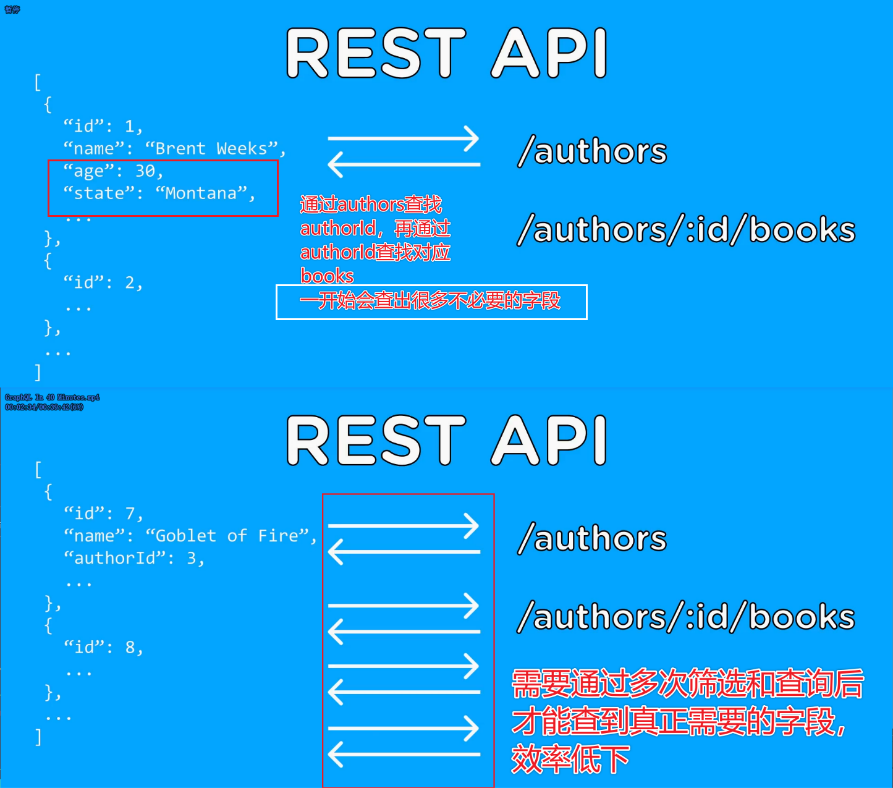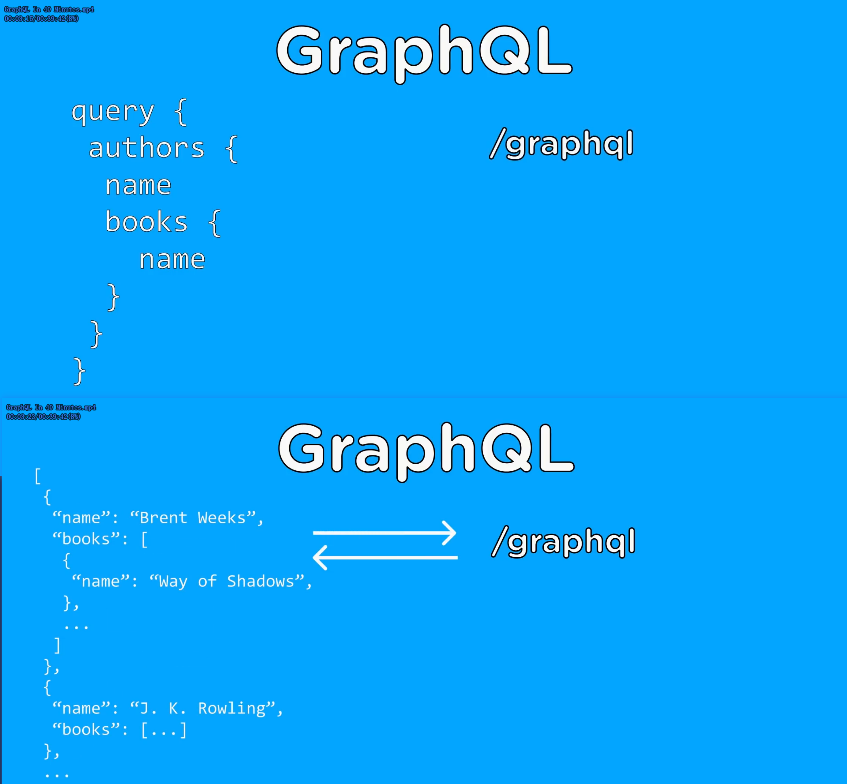
去年自学了GraphQL,这里重新整理一下笔记。国内使用GraphQL的项目毕竟还不多,这里写个demo,做个小小的探索。
GraphQL是facebook发明的一套API查询语言,支持多种语言,这里用js演示,官网有详细的说明
比起传统的后端API整合
GraphQL为你的API数据提供了一种完整且易于理解的描述。(GraphQL provides a complete and understandable description of the data in your API)
以上是官网对GraphQL的解释,利用GraphQL可以按需取字段给前端利用,不必取到不需要的字段,见下图解释:
GraphQL则可以精确查找想要的字段,效率显著提高:
下面,结合自己写的demo:https://github.com/ys558/tech-blog-code/tree/master/2020/04-graphql-learn 完成以下完成本篇博客:
一、HelloWorld
- 将项目拉下来后,cd到对应目录下,用
npm install或yarn安装依赖,运行npm run hello或yarn hello,先从 01helloworld.js 文件跑起,浏览器运行http://localhost:5000/
左边输入框输入1
2
3query {
message
}
注意,这种是GraphQL特有的查询语法
点击运行,( 或快捷键 ctrl+enter ) 后,右边会显示:
graphqlHTTP为express-graphql库解构的实例1
const { graphqlHTTP } = require('express-graphql')
- GraphQL自带图形化界面且友好,,只需在实例
graphqlHTTP中设置graphiql: true即可:1
app.use('/', graphqlHTTP({ schema, graphiql: true }))
- 在query实例中,
fields字段用于设置查询条件,是回调函数, fields函数返回的东西用resolve函数接收其返回结果,接收结果也为回调函数- 在接收结果中,可以规定其返回类型
type,其值为 Scalar Type (标量类型)1
2
3
4
5
6
7
8
9
10
11const schema = new GraphQLSchema({
query: new GraphQLObjectType({
name: 'helloWorld',
fields: () => ({
message: {
type: GraphQLString,
resolve: () => 'Hello World'
}
})
})
})
二、基础操作
运行
npm run ds2或yarn ds2,浏览器跑http://localhost:5000/books,1
2
3
4
5
6{
books {
id
name
}
}输入以上条件,通过 books 字段查询其对应的 id, name 后运行,可以查询出以下结果:

02base.js 解析:
- books查询出来的为一数组,其标量 定义为
GraphQLList1
2
3
4
5
6
7
8
9
10
11
12
13
14
15
16
17
18
19
20
21
22
23const RootQueryType = new GraphQLObjectType({
name: 'Query',
description: 'Root Query',
fields: () => ({
/* 第一个 books 是命名,也可叫 aaa,如果改 aaa 则
在 query 条件改为:
aaa {
books {
id
name
}
}
*/
books: {
// BookType as params pass to RootQueryType
type: new GraphQLList(BookType),
description: 'List of all books',
// 这里的 books 对应实际的 books 数组,
// 要查询数组 books里的东西:
resolve: () => books
}
})
}) BookType独立为标量GraphQLObjectType的实例化,由于其为最后一层数据,无需向下深挖,所以resolve方法不需要GraphQLNonNull表示该字段为必须字段1
2
3
4
5
6
7
8const BookType = new GraphQLObjectType({
name: 'Book',
description: 'this is represents a book written by an author',
fields: () => ({
id: { type: GraphQLNonNull(GraphQLInt) },
name: { type: GraphQLNonNull(GraphQLString) },
})
})
三、通过书籍查询对应作者(一对一关系查询)及作者查询对应的书籍信息(一对多查询)
跑
03listQuery.js文件,输入1
2
3
4
5
6
7
8{
authors {
books {
id
name
}
}
}可以得到结果:

解析
03listQuery.js:
可以按照上面的方法继续丰富查询,建立一个模拟数据
author,内容如下:1
2
3
4
5const authors = [
{ id: 1, name: 'J. K. Rowling'},
{ id: 2, name: 'J. R. R. Tolkien'},
{ id: 3, name: 'Brent Weeks'},
]同样的,建立两个实例查询对应信息:
resolve部分对应相应的数据1
2
3
4
5
6
7
8
9
10
11
12{
books: {
type: new GraphQLList(BookType),
description: 'List of all books',
resolve: () => books
},
authors: {
type: new GraphQLList(AuthorType),
description: 'List of all Authors',
resolve: () => authors
}
}根据上面的字段名字
books和authors创建对应的查询实例:books实例里,
id,name,authorId均是books对象里的,可直接查出,author字段在author数组里books数据有关联的是authorId,用js的数组方法.find()去找books <–> authors 是一对一的关系,
AuthorType本身就是GraphQLObjectType标量,可直接使用1
2
3
4
5
6
7
8
9
10
11
12
13
14
15
16const BookType = new GraphQLObjectType({
name: 'Book',
description: 'this is represents a book written by an author',
fields: () => ({
id: { type: GraphQLNonNull(GraphQLInt) },
name: { type: GraphQLNonNull(GraphQLString) },
authorId: { type: GraphQLNonNull(GraphQLInt)},
author: {
type: AuthorType,
// query book by authorId
resolve: book => {
return authors.find( author => author.id === book.authorId )
}
}
})
})authors实例也是同样道理
authors <–> books 是一对多的关系,
BookType实例要装入GraphQLList标量中1
2
3
4
5
6
7
8
9
10
11
12
13
14
15const AuthorType = new GraphQLObjectType({
name: 'Author',
description: 'this is represents a author of a book',
fields: () => ({
id: { type: GraphQLNonNull(GraphQLInt) },
name: { type: GraphQLNonNull(GraphQLString) },
// query author by book's id
books: {
type: new GraphQLList(BookType),
resolve: author => {
return books.filter(book => book.authorId === author.id)
}
}
})
})
四、通过书籍id查询书本信息
- 运行
04singleQuery.js,输入以下查询条件:
1 | { |
执行结果如下:

输入以下条件
1
2
3
4
5
6
7
8{
book(id: 4) {
name
author {
name
}
}
}
执行结果如下:

- 从以上的查询条件
book(id: 4)可看出,通过传参id查询具体书籍信息,这里的id就体现在args参数上: args在resolve函数里处于第二个参数的位置1
2
3
4
5
6
7book: {
type: BookType,
description: 'A Single Book',
// must query this book by params of book id:
args: { id: { type: GraphQLInt } },
resolve: ( parent, args ) => books.find( book => book.id === args.id )
},- 同样的,
author也可以按照传入authorId查询得到:用1
2
3
4
5
6
7author: {
type: AuthorType,
description: 'A Single Author',
// query an author by params of author id:
args: { id: { type: GraphQLInt } },
resolve: ( parent, args ) => authors.find( author => author.id === args.id )
},author(id)查询结果:
五、修改数据(MutationType)
运行
yarn ds5,浏览器输入:1
2
3
4
5
6mutation {
addBook(name: "new book", authorId: 1) {
id
name
}
}可以看到增加单本书成功:

输入:
1
2
3
4
5mutation {
addAuthor(name: "new author") {
name
}
}可以看到增加一个作者成功:

点击右上角的 < Docs,可以发现该文件的Mutation函数,其中
!意为必要字段:

- 想要实现
Mutation Type须在GraphQLSchema实例里添加mutation类型:1
2
3
4const Schema = new GraphQLSchema({
query: RootQueryType,
mutation: RootMutationType
}) - 和普通的
Query Type类似,只不过Mutation Type在resolve里直接对数据进行改动而已:1
2
3
4
5
6
7
8
9
10
11
12
13
14
15
16
17
18
19
20
21
22
23
24
25
26
27fields: () => ({
addBook: {
type: BookType,
description: 'Add a book',
args: {
name: { type: GraphQLNonNull(GraphQLString) },
authorId: { type: GraphQLNonNull(GraphQLInt) }
},
resolve: ( parent, args ) => {
const book = { id: books.length + 1, name: args.name, authorId: args.authorId }
books.push(book)
return book
}
},
addAuthor: {
type: AuthorType,
description: 'Add a author',
args: {
name: { type: GraphQLNonNull(GraphQLString) }
},
resolve: ( parent, args ) => {
const author = { id: authors.length + 1, name: args.name }
authors.push(author)
return author
}
},
})





